Warrington, Lancashire
Up to 1834
A parish meeting at Warrington in August 1712 agreed to erect a workhouse. The building was erected on Church Street in 1728 and accommodated around 100 inmates. In the second edition of An Account of Several Workhouses..., a report from Warrington, dated August 18th, 1729, noted that:
In 1776, the workhouse could accommodate 100 paupers. Eden, in his 1797 survey of the poor in England, reported of Warrington that:
1st May, 1792, to 1st May, 1793 1s. 6¾d.The Workhouse is an old one, but is kept very clean, and the Poor there seem very contented. The beds are filled with chaff, and are well provided with covering.
1st May, 1793, to 1st May, 1794 1s. 6d.
1st May, 1794, to 1st May, 1795 1s. 4d.
The workhouse, located on Church Street, was a three-storey U-shaped building at the north end of a long, narrow site. The ground floor of the main building included an entrance hall, board room, kitchen, dining-hall, washhouse (laundry) and boys' school. A separate infirmary stood at the south of the site with gardens surrounding it. The Tavern pub now stands on the site.
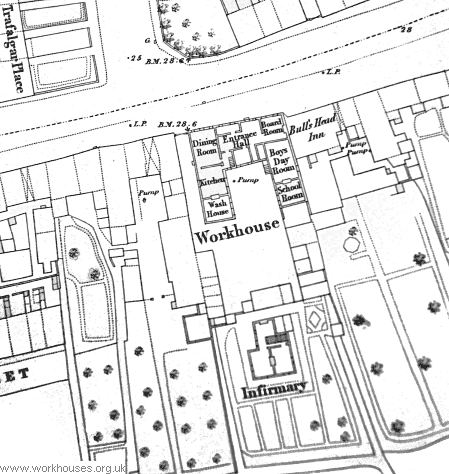
Warrington Church Street workhouse site, 1849.
The rules of the house in 1820 included the barring of alcohol, no spitting or filth of any kind, no profane swearing, cursing or "obscene jests". There was also a ban on the "reading of songs, ballads, books or publications of an immoral tendency"
A workhouse was opened at Poulton with Fearnhead in around 1740 (Hitchcock, 1985).
A parliamentary report of 1777 recorded workhouses at Cuerdley (for up to 50 inmates ) and at Great Sankey (45).
Newton-le-Willows had a workhouse on Bridge Street.
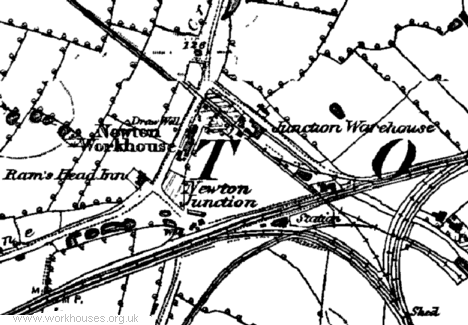
Newton-le-Willows workhouse site, 1849.
After 1834
Warrington Poor Law Union was formed on 2nd February, 1837. Its operation was overseen by an elected Board of Guardians, 18 in number, representing its 15 constituent parishes or townships as listed below (figures in brackets indicate numbers of Guardians if more than one):
Lancashire:
Burtonwood, Cuerdley, Golborne, Haydock; Houghton, Middletown and Arbury; Kenyon, Newton in Mackerfield, Penketh, Poulton with Fearnhead, Rixton with Glazebrook, Great Sankey, Southworth and Croft, Warrington (4), Woolstone with Martinscrofts, Winwick.
Later Addition: Little Sankey (from 1894).
The population falling within the union at the 1831 census had been 27,757 with parishes or townships ranging in size from Houghton, Middletown and Arbury (population 286) to Warrington itself (16,018).
Initially, the new Warrington Union took over existing township workhouses at Warrington and Newton-le-Willows.
Lovely Lane Workhouse
A new Warrington Union workhouse was built in 1849-51 at the east side of Lovely lane in Warrington, with its entrance from Guardian Street at the south of the site. The south-facing main building was a long two-storey block with three-storey central section and three-storey cross wings at each end. A dining hall and kitchens were located in the central rear wing with a separate chapel standing immediately to the north. Casual wards for vagrants were placed at the entrance to the site from Guardian Street.
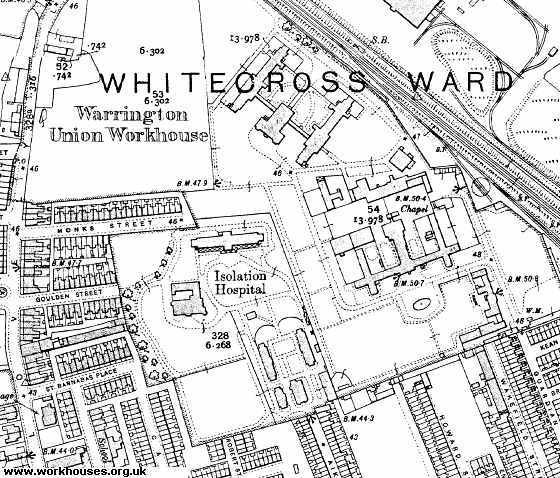
Warrington workhouse site, 1905.
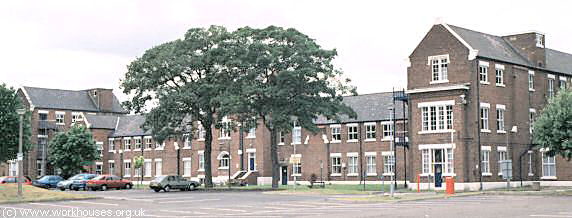
Warrington main block from the south-east, 2001.
© Peter Higginbotham.
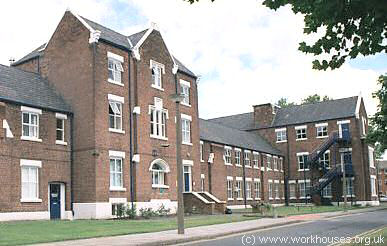
Warrington main block from the south-west, 2001.
© Peter Higginbotham.
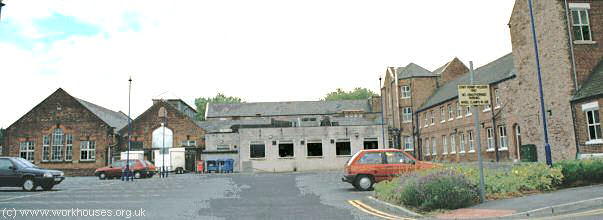
Warrington chapel, dining-hall and rear of main block from the west, 2001.
© Peter Higginbotham.
By 1893, there an isolation hospital for infectious had been constructed at the south-west of the workhouse. In around 1898 a large infirmary was built to the north of the workhouse site. It comprised a central administrative block flanked by separate male and female pavilions.
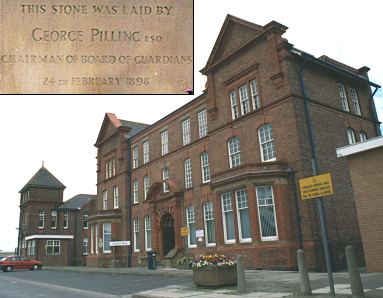
Warrington 1898 infirmary from the north, 2001.
© Peter Higginbotham.
From 1904, to protect them from disadvantage in later life, the birth certificates for those born in the workhouse gave its address just as 99 Guardian Street, Warrington.
During the First World War, the site became home to Whitecross Military Hospital.
After 1930, the workhouse became Whitecross Institution and Hospital. With the inauguration of the National Health Service in 1948, the original workhouse buildings became Whitecross Homes and Hospital; the 1898 infirmary became Warrington General Hospital; and the isolation hospital became Aikin Street Hospital. In 1973, all the institutions on the site were united as Warrington District General Hospital.
Padgate Industrial Schools
In 1880-1, Warrington Union erected an Industrial School complex at Padgate. The site provided accommodation and training for pauper children away from the main workhouse site. The buildings included two boys' houses, two girls' houses, a school, Superintendent's house, and Porter's lodge. Play sheds were added in 1885. The site location and layout are shown on the 1905 map below.
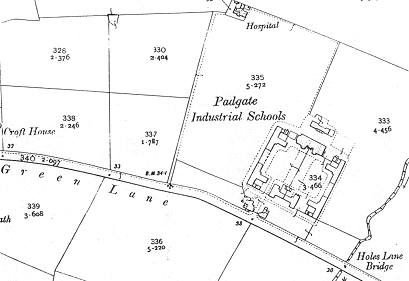
Warrington Padgate schools site, 1905.
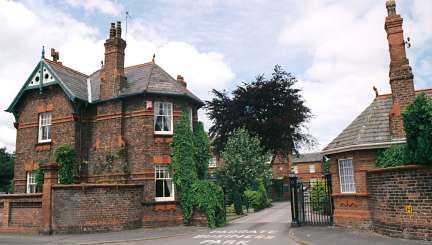
Padgate Superintendent's house (left) and Porter's lodge from the south, 2001.
© Peter Higginbotham.
The children's accommodation comprised two T-shaped houses for each sex. The homes could eventually accommodate 200 children.
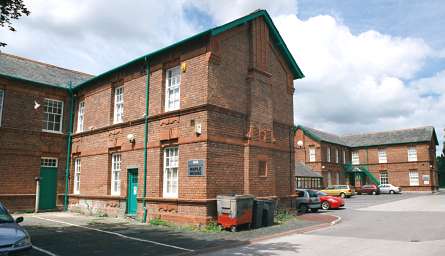
Padgate boys' houses from the south, 2001.
© Peter Higginbotham.
The school, to the north-east of the Porter's lodge, has a foundation stone laid by WE Winstanley on 7th October 1880.
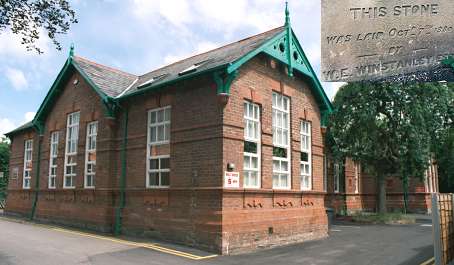
Padgate school block from the south, 2001.
© Peter Higginbotham.
The Industrial Schools later became Padgate Cottage Homes. The surviving buildings have now been converted for business use.
Staff
Inmates
Records
Note: many repositories impose a closure period of up to 100 years for records identifying individuals. Before travelling a long distance, always check that the records you want to consult will be available.
- Lancashire Record Office, Bow Lane, Preston, Lancashire, PR1 2RE. Few records survive — main holdings are Guardians' minutes (1837-1900).
Bibliography
- Forrest, D (2001) Warrington's Poor and the Workhouse, 1725-1851.
- Hitchcock, T.V. (1985) The English workhouse: a study in institutional poor relief in selected counties. l695-l750. (DPhil thesis. University of Oxford.)
Links
Unless otherwise indicated, this page () is copyright Peter Higginbotham. Contents may not be reproduced without permission.


